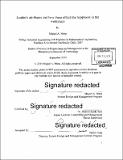| dc.contributor.advisor | halom Saada Saar. | en_US |
| dc.contributor.author | Musa, Miguel Á. (Miguel Ángel) | en_US |
| dc.contributor.other | System Design and Management Program. | en_US |
| dc.date.accessioned | 2016-11-14T19:06:21Z | |
| dc.date.available | 2016-11-14T19:06:21Z | |
| dc.date.copyright | 2015 | en_US |
| dc.date.issued | 2015 | en_US |
| dc.identifier.uri | http://hdl.handle.net/1721.1/105314 | |
| dc.description | Thesis: S.M. in Engineering and Management, Massachusetts Institute of Technology, Engineering Systems Division, 2015. | en_US |
| dc.description | Cataloged from PDF version of thesis. | en_US |
| dc.description | Includes bibliographical references (pages 98-104). | en_US |
| dc.description.abstract | The purpose of this thesis work is to explore what specific aspects or attributes of a leader (in a broad definition) contribute positively (or negatively) to the happiness of workers. In order to do so, happiness at work is defined based in constructs used in past researches such as well-being, affect, job satisfaction, engagement, job involvement, etc. These constructs were categorized in three levels of happiness. Firstly, the transient level, which measures short-term moods and emotions lived by the individual. Secondly, in a more long term, the person level measures duration or stability of happiness over time. Finally, the unit level measures happiness of teams, units or organizations. On the other hand, 34 attributes of a leader which are representative of a good leader were chosen from literature review. Afterwards, data was collected through an electronic survey that asked respondents to assess how each of the 34 attributes affected the constructs that compose each level of happiness. The results show that all 34 attributes affect the transient, person and unit level of happiness. However, respondents thought that for the transient level of happiness a leader affects more through attributes that are visible and flow from the leader to their followers, while in the person level attributes related to their personal character (more abstract) were balanced with the more visible ones. On the other hand, in the unit level, value-oriented attributes were thought to be important as well. In addition to this, factors such as gender, work experience, and the size of the unit can change the attributes that affect the most happiness at work of the group in its different levels. In conclusion, depending on the level of happiness and the type of people that compose a group, different attributes of a leader will be needed to increase the desired level of happiness. | en_US |
| dc.description.statementofresponsibility | by Miguel A. Musa. | en_US |
| dc.format.extent | 104 pages | en_US |
| dc.language.iso | eng | en_US |
| dc.publisher | Massachusetts Institute of Technology | en_US |
| dc.rights | M.I.T. theses are protected by copyright. They may be viewed from this source for any purpose, but reproduction or distribution in any format is prohibited without written permission. See provided URL for inquiries about permission. | en_US |
| dc.rights.uri | http://dspace.mit.edu/handle/1721.1/7582 | en_US |
| dc.subject | Engineering Systems Division. | en_US |
| dc.subject | System Design and Management Program. | en_US |
| dc.title | Leader's attributes and how these affect the happiness in the workplace | en_US |
| dc.type | Thesis | en_US |
| dc.description.degree | S.M. in Engineering and Management | en_US |
| dc.contributor.department | System Design and Management Program. | en_US |
| dc.contributor.department | Massachusetts Institute of Technology. Engineering Systems Division | |
| dc.identifier.oclc | 962359749 | en_US |
